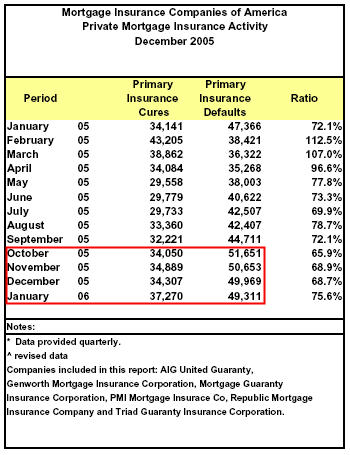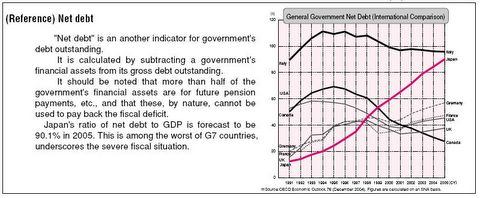In Lewis Carroll's Through the Looking-Glass there is an incident involving the Red Queen, a representation of a Queen in chess, and Alice constantly running but remaining in the same spot. The scene is often referred to as
The Red Queen's Race.
The Queen kept crying "Faster!" but Alice felt she could not go faster, though she had no breath to say so. The most curious part of the thing was, that the trees and the other things round them never changed their places at all: however fast they went, they never seemed to pass anything. "I wonder if all the things move along with us?" thought poor puzzled Alice. And the Queen seemed to guess her thoughts, for she cried, "Faster! Don't try to talk!"
Not that Alice had any idea of doing that. She felt as if she would never be able to talk again, she was getting so out of breath: and still the Queen cried, "Faster! Faster!" and dragged her along. "Are we nearly there?" Alice managed to pant out at last.
"Nearly there!" the Queen repeated. "Why, we passed it ten minutes ago! Faster!" And they ran on for a time in silence, with the wind whistling in Alice's ears, and almost blowing her hair off her head, she fancied.
"Now! Now!" cried the Queen. "Faster! Faster!" And they went so fast that at last they seemed to skim through the air, hardly touching the ground with their feet, till suddenly, just as Alice was getting quite exhausted, they stopped, and she found herself sitting on the ground, breathless and giddy. The Queen propped her against a tree, and said kindly, "You may rest a little now."
Alice looked round her in great surprise. "Why, I do believe we've been under this tree all the time! Everything's just as it was!"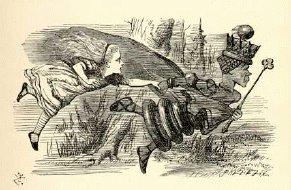 "Of course it is," said the Queen: "what would you have it?""Well, in our country," said Alice, still panting a little, "you'd generally get to somewhere else -- if you ran very fast for a long time, as we've been doing.""A slow sort of country!" said the Queen. "Now, here, you see, it takes all the running you can do, to keep in the same place. If you want to get somewhere else, you must run at least twice as fast as that!"
"Of course it is," said the Queen: "what would you have it?""Well, in our country," said Alice, still panting a little, "you'd generally get to somewhere else -- if you ran very fast for a long time, as we've been doing.""A slow sort of country!" said the Queen. "Now, here, you see, it takes all the running you can do, to keep in the same place. If you want to get somewhere else, you must run at least twice as fast as that!" The above image is thanks to the
University of Virginia Library.
The Red Queen Race vs. the US EconomyFollowing is a chart of US GDP. It seems to have stalled.

Yet money and credit is still expanding.

Can consumers forever keep spending more than they make?
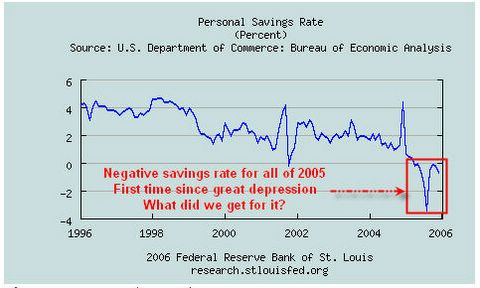
Government spending still climbs at a steady pace.
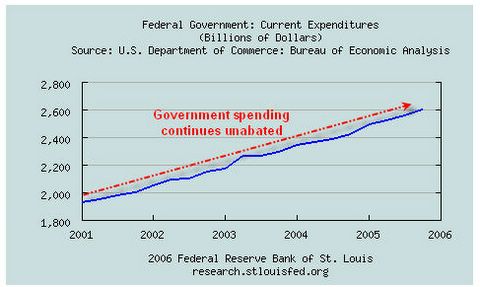
Spending is increasing far faster than revenues.
Is this sustainable?
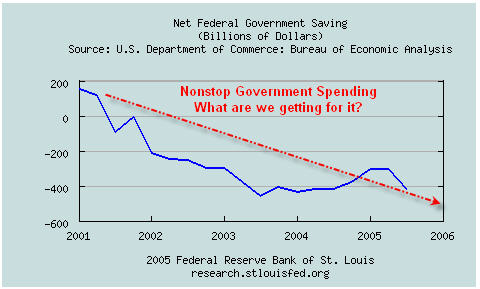
Following is a chart of the CPI as published by the government.
Does anyone believe it?
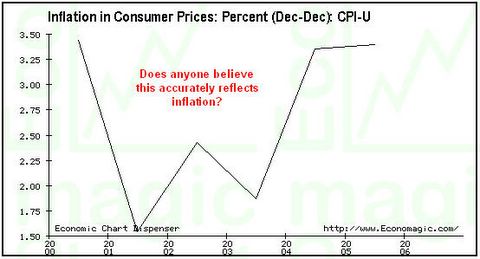
Mish notes:
Yes, I realize that M3 is grossly distorted.
Unfortunately practically all government numbers are.
The CPI is certainly inaccurate and is probably understated.
It is impossible to say by how much as noted in
Inflation: What the heck is it?What we can say is that the CPI is subject to massive government manipulation.
We can also say that the GDP is distorted by hedonics and imputations.
Those not familiar with the concept of paying oneself rent and adjusting the GDP for "the value" of free checking accounts may wish to read
Grossly Distorted Procedures.
Let's take a look at 4th quarter US GDPThe
US economy hits the brakes in fourth quarter.
US gross domestic product, after expanding by an annualized 4.1 percent over July-September, dropped to its weakest pace in three years after 10 consecutive quarters of growth above 3.0 percent.
Economists said the surprising report foreshadowed a more moderate pace of expansion for the world's biggest economy in 2006.
But Treasury Secretary John Snow dismissed the GDP slowdown as "anomalous" and stressed the preliminary report was subject to revisions.
"Economic fundamentals point to continued strong economic performance in the United States in 2006. The US economy is performing well," he said.
"This report is the worst-case scenario for the Fed and Mr. Bernanke, and the new Fed chair will be tested right off the bat," commented Joel Naroff of Naroff Economic Advisors.
"The economy is slowing, though clearly not as rapidly as the headline number would have you think. At the same time, inflation is slowly accelerating," he said.
The GDP report showed that over 2005, the personal savings rate of Americans was negative for the first year since the depths of the Great Depression in 1933.
A spending binge by US consumers on the back of a red-hot property market has done much to elevate GDP growth in recent years. But housing has shown signs of slowing, triggering fears that consumers could rein in spending.
Other figures out Friday showed that sales of new US homes increased a surprising 2.9 percent in December. But the inventory of unsold homes increased 2.4 percent to a record 516,000.
The GDP report showed that consumer spending increased at an annual rate of 1.1 percent, down heavily from 4.1 percent in the third quarter. It was the slowest spending pace since the last US recession in mid-2001.
Notice how backwards the thinking is:
"But housing has shown signs of slowing, triggering fears that consumers could rein in spending." Any rational person looking at the negative savings rate, the trade deficit, and rampant government spending should not be fearing a slowdown in consumer spending, the fear should be that consumer spending continues!
Posting on Kitco, Trotsky writes:
Since 2000, the US economy has officially grown by $1.4 trillion (inflation-adjusted GDP growth) . Over the same period, total credit market debt outstanding has grown by an astounding $9 trillion. Personal (household) debts alone have exploded by 60% over the past 5 years, from already elevated levels ($6.9 trillion to $11 trillion) . Nearly 90% of the reported GDP growth was in consumption and residential building. The "recovery" continues to be the weakest post WW2 recovery on record, with capital spending stuck in limbo, real wages declining and job growth non-existent (private sector employment has risen only 1% since 2000 - compared to the 9% average of other post WW2 recoveries) .Right now it takes a negative savings rate, expanding credit, and excessive government spending just to stand in one spot. The charts above prove it. Furthermore, if one subtracts imputations and hedonics, and adjusts the GDP by a CPI that better reflects reality, the logical conclusion is that the GDP was actually negative last quarter.
Let's consider one more passageway from Through the Looking-Glass:
I SHOULD see the garden far better," said Alice to herself, "if I could get to the top of that hill: and here's a path that leads straight to it -- at least, no, it doesn't do that -- -" (after going a few yards along the path, and turinng several sharp corners), "but I suppose it will at last. But how curiously it twists! It's more like a corkscrew than a path! Well, this turn goes to the hill, I suppose -- no, it doesn't! This goes straight back to the house! Well then, I'll try it the other way."
And so she did: wandering up and down, and "trying turn after turn, but always coming back to the house, do what she would. Indeed, once, when she turned a corner rather more quickly than usual, she ran against it before she could stop herself. In "Wonderland" forward movements take one back to their starting point and rapid movements can cause very abrupt stops.
I picture Ben Bernanke as the new Red Queen.
He is now trapped in
Zugzwang.
Definition: A German term for the obligation to move. All legal moves lead to a worsening of the position.
Click on the above link for multiple chess possibilities. Here is one example (taking poetic license) as the position shows a red king not a queen.

For non-chess fans who might not fully understand the above position: no matter which way Bernanke moves, white will next capture the red pawn, and march the remaining white pawn to victory. The red king can not capture the white pawn or move one square forward since either would put the king in "check" (subject to capture by the opposing king or pawn).
In economic terms, there is no magic mirror.
Bernanke is trapped in "Wonderland" but unlike Alice has no way out.
Bernanke gets to choose between hyperinflation and deflation.
The moment he can not run fast enough, the US economy will implode.
If he runs too fast, the value of the US dollar as well as the FED's power will both come to a very abrupt stop.
In effect Bernanke is in Zugzwang and he does not even know it.
Economic Checkmate.
Mike Shedlock / Mish
http://globaleconomicanalysis.blogspot.com/

